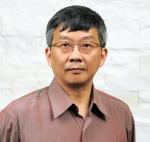Trimeric precursors in formation of Al magic clusters on a Si(111)-7 x 7 surface
- Citation:
- Liu, H. J., Chou J. P., Li R. W., Wei C. M., & Miki K. (2011). Trimeric precursors in formation of Al magic clusters on a Si(111)-7 x 7 surface. Physical Review B. 83, 6., Feb, Number 7
Abstract:
The formation process of Al magic clusters on the Si(111)-7 x 7 surface was investigated by means of a variable-temperature scanning tunneling microscope (STM) in situ and was interpreted using density-functional theory (DFT) calculations. At a growth temperature of 450 degrees C, Al atoms hopped among the corner, center, and T4 sites and also across the dimer rows on the Si(111)-7 x 7 surface. At low coverage below 0.08 ML, a single Al atom was adsorbed on the corner or center site. When the coverage was increased to 0.08 ML, Al dimers and trimers appeared, and Al magic clusters were also observed. However, no Al tetramers or pentamers were experimentally confirmed. Careful analysis of STM images suggests that Al trimers could be key precursors for the formation of Al magic clusters, and DFT calculations verified this interpretation. Total-energy calculation results using DFT reveal that this is due to the small energy gain from Al trimer to Al tetramer. These results are important for understanding the atomic structure and the formation mechanism of the magic clusters on the Si(111)-7 x 7 surface.
Notes:
ISI Document Delivery No.: 717GPTimes Cited: 1Cited Reference Count: 26Cited References: Barth JV, 2005, NATURE, V437, P671, DOI 10.1038/nature04166 Brune H., 1998, SURF SCI REP, V31, P125, DOI 10.1016/S0167-5729(99)80001-6 Chen C. J., 1993, INTRO SCANNING TUNNE Cho KJ, 1998, SURF SCI, V396, pL261, DOI 10.1016/S0039-6028(97)00848-0 CHOU J, UNPUB Hohenberg P, 1964, PHYS REV, V136, pB684, DOI DOI 10.1103/PHYSREV.136.B864 Jia JF, 2002, APPL PHYS LETT, V80, P3186, DOI 10.1063/1.1474620 Jia JF, 2002, NANOTECHNOLOGY, V13, P736, DOI 10.1088/0957-4484/13/6/308 Jia JF, 2002, PHYS REV B, V66, DOI 10.1103/PhysRevB.66.165412 Li Jian-Long, 2002, Phys Rev Lett, V88, P066101, DOI 10.1103/PhysRevLett.88.066101 Kohn W., 1965, PHYS REV, V140, pA1135 Kotlyar VG, 2002, PHYS REV B, V66, DOI 10.1103/PhysRevB.66.165401 KRESSE G, 1993, PHYS REV B, V47, P558, DOI 10.1103/PhysRevB.47.558 Kresse G, 1999, PHYS REV B, V59, P1758, DOI 10.1103/PhysRevB.59.1758 Lai MY, 2001, PHYS REV B, V64, DOI 10.1103/PhysRevB.64.241404 Li RW, 2007, PHYS REV B, V76, DOI 10.1103/PhysRevB.76.075418 Li RW, 2006, NANOTECHNOLOGY, V17, P2018, DOI 10.1088/0957-4484/17/8/038 Li RW, 2006, APPL PHYS LETT, V89, DOI 10.1063/1.2337522 Li SC, 2004, PHYS REV LETT, V93, DOI 10.1103/PhysRevLett.93.116103 Pan MH, 2005, NANO LETT, V5, P87, DOI 10.1021/nl048925s RODER H, 1993, NATURE, V366, P141, DOI 10.1038/366141a0 Uchida H, 2004, PHYS STATUS SOLIDI B, V241, P1665, DOI 10.1002/pssb.200304687 Uchida H, 2004, SURF SCI, V566, P197, DOI 10.1016/j.susc.2004.06.107 Vitali L, 1999, PHYS REV LETT, V83, P316, DOI 10.1103/PhysRevLett.83.316 Wu KH, 2003, PHYS REV LETT, V91, DOI 10.1103/PhysRevLett.91.126101 Zhang C, 2005, PHYS REV LETT, V94, DOI 10.1103/PhysRevLett.94.176104Liu, Hongjun Chou, Jyh-Pin Li, Run-Wei Wei, Ching-Ming Miki, KazushiMinistry of Education, Culture, Sports, Science and Technology (MEXT) of Japan; Iketani Science and Technology Foundation; Japanese Society for the Promotion of Science; National Science Council of Taiwan [NSC96-2628-M-001-006-MY3, NSC99-2112-M-034-MY3]We thank Dr. James Owen for his comments and revision of the manuscript. We thank Dr. Canhua Liu for fruitful discussion. This research was partially supported by the Ministry of Education, Culture, Sports, Science and Technology (MEXT) of Japan, Grant-in-Aid for Scientific Research, the Iketani Science and Technology Foundation, and the A3 Foresight Program of the Japanese Society for the Promotion of Science. This work was also supported in part by the National Science Council of Taiwan under Grants No. NSC96-2628-M-001-006-MY3 and No. NSC99-2112-M-034-MY3.AMER PHYSICAL SOCCOLLEGE PK

